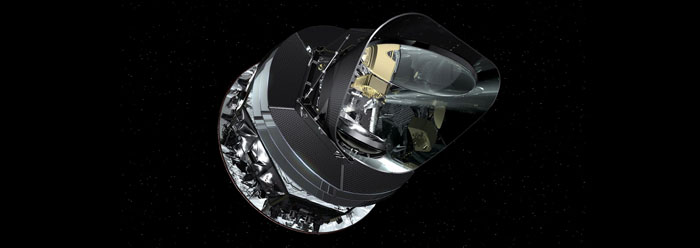During a high profile news conference in March 2014, the BICEP2 radio astronomy team announced purported direct evidence for inflation— an important part of the modern Big Bang model.1
In Big Bang cosmology, inflation is a hypothesized "growth spurt" in which the universe enormously increased in size. Inflation was an ad hoc addition to the Big Bang model intended to solve some very serious theoretical difficulties, including the Big Bang's own version of the seeing-distant-starlight-in-a-young- universe problem.2 Inflation was originally thought to have occurred shortly after the Big Bang, although secular cosmologists have since begun to view inflation as the actual cause of this alleged cosmic explosion.3 Hence, finding evidence for this hypothesized inflationary process is quite important to Big Bang proponents.
Nearly uniform radiation comes to Earth from all directions. Because this radiation has its peak intensity in the microwave portion of the electromagnetic spectrum, it's called the cosmic microwave background (CMB) radiation. Secular cosmologists interpret this radiation as an afterglow from a time about 400,000 years after the supposed Big Bang.
The BICEP2 team found swirly patterns in the CMB radiation called B-mode polarization. These were thought to have been imprinted on the CMB by primordial "gravity waves" during the inflationary process.
Big Bang advocates were of course jubilant at the time. However, mere months after the big announcement, other scientists noticed a flaw in the analysis: the BICEP2 team had seriously underestimated the amount of B-mode polarization that could be caused by microwaves emitted by dust within our own galaxy.4 Hence, the CMB polarization patterns cited as "smoking gun" evidence for the Big Bang quite possibly had nothing to do with this hypothesized inflationary process. One prominent theoretical physicist even called this embarrassing episode a "Big Bang blunder."5
However, the BICEP2 radio telescope was not the only source of information regarding this microwave background radiation. CMB measurements had also been obtained by the Planck satellite, and initial results of the Planck data analysis were released in 2013.6 But this preliminary report did not include a study of the B-mode polarization within the CMB causing some to hold out hope that analysis of the Planck CMB data would provide the needed evidence for inflation, apart from the flawed BICEP2 analysis. That claim has not been realized.
Analysis of polarization patterns within the CMB, obtained from the Planck data, has now been presented in a paper submitted for publication last month.7 Its authors concluded that the "noise" caused by dust within our own galaxy is about the same size as the signal detected by the BICEP2 team. Hence, analysis of the Planck data has confirmed that the signal detected by the BICEP2 team is likely to have been caused by dust within our own Milky Way galaxy.
To make matters even worse for Big Bang proponents, researchers from King's College London have argued that accepting the BICEP2 claim at face value would imply that the universe should have collapsed in on itself shortly after the supposed Big Bang. Hence, if the BICEP2 results were correct, our universe should not even exist!8
As we noted at the time of the initial BICEP2 announcement, this is not the first sensationalistic "proof" of secular stories about origins that has been walked back by secular scientists, nor will it be the last.9 With so many such defeated proofs littering the scientific landscape (Piltdown Man, vestigial organs, the supposed missing link "Ida," smoking gun evidence for the Big Bang, etc.), one would think that Christians would learn not to be so intimidated by the dogmatic claims of secular scientists. Yet many Christians are still reluctant to question the scientific "high priests" of the new secular religion and can only bring themselves to meekly suggest, against all logic and common sense, that perhaps such claims don't really contradict the Bible after all! This recent debacle should encourage Christians to toughen up and exhibit a little hard-nosed skepticism the next time scientists announce the latest "proof" for their theories. After all, aren't secular scientists always telling us that skepticism is a virtue?
References
- Overbye, D. 2014. Space Ripples Reveal Big Bang's Smoking Gun. New York Times. Posted on nytimes.com March 17, 2014, accessed March 17, 2014.
- Lisle, J. 2003. Light-travel time: a problem for the big bang. Creation. 25 (4): 48-49.
- Guth, A. The Inflationary Universe: Alan Guth. Edge. Posted on edge.org November 19, 2002, accessed March 17, 2014.
- Cho, Adrian. Doubts Shroud Big Bang Discovery. Science. Posted on sciencemag.org May 19, 2014 accessed May 21, 2014.
- Steinhardt, P. 2014. Big Bang blunder bursts the multiverse bubble. Nature. 510 (7503): 9.
- Hebert, J. 2013. The Planck Data and the Big Bang. Creation Science Update. Posted on icr.org April 3, 2013, accessed September 24, 2014.
- Adam, R. et al. 2014. Planck intermediate results. XXX. The angular power spectrum of polarized dust emission at intermediate and high Galactic latitudes. Submitted to Astronomy and Astrophysics. Pre-print submitted to arxiv.org on September 19, 2014, accessed September 24, 2014.
- Parnell, B. A. Higgs Boson Seems to Prove that the Universe Doesn't Exist. Forbes.com. Posted on forbes.com June 24, 2014, accessed September 24, 2014.
- Hebert, J. 2014. 'Smoking Gun' Evidence of Inflation? Creation Science Update. Posted on icr.org March 21, 2014, accessed September 24, 2014.
Image credit: ESA/NASA/JPL-Caltech
* Dr. Hebert is Research Associate at the Institute for Creation Research and received his Ph.D. in physics from the University of Texas at Dallas.
Article posted on October 13, 2014.

















